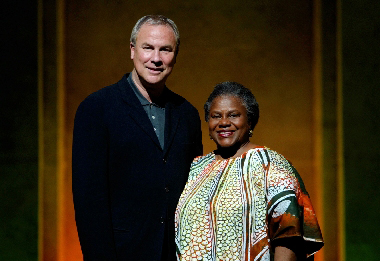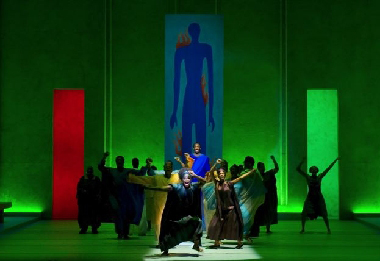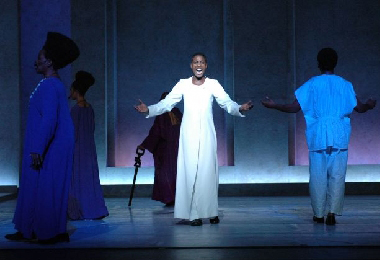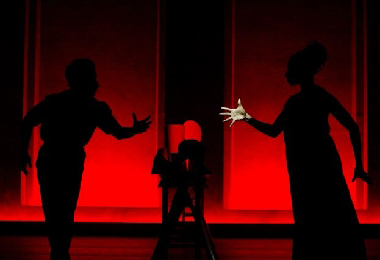|
|
| testo italiano | |
[ conversations ]
|
Robert Wilson,
Glimpsing Beyond The Impossible
|
 |
 |
 |
 |
|||
|
On top, on the left: Robert Wilson and Bernice Johnson Reagon, photo by Brinkoff/Mogenburg
The temptations of Saint Anthony, photo by Stephanie Berger |
||||
|
In your works, you often focus your attention on quotes and elements of painting (and architecture). Did you carry out these elements in your last work? Considering for example the pictorial references of Flaubert’s work (notably, the Neapolitan Domenico Morelli) or, apart from the novel, did you think about the traditional iconography dedicated to Temptations? (Bosch in particular)?
The world is a library. I draw from all sources.
Outwardly and inwardly. When creating a piece I always start from the space.
Then I create a structure in time. Finally, when all the visual elements are in
place, I have created a frame for the performers to fill. If the structure is
solid, then one can be free in it.
Often people ask me what my theater is about: usually I say I do not know. If we
know what we are doing, there is no reason to do it. My work is, in most cases,
formal. It is not interpretative. To me interpretation is not the
responsibility of the director, the author or the performer: interpretation is
for the public. The steps of my work are very clear to me: I started with some
“mute works”, the ones that the French critics called “structured silences”. I have always been interested in something that is in between art and life. I
simply like to consider my theater as the work of an artist.
In your theater, moving within the areas of contamination among different arts,
you pioneered working with a constant tension towards electronics, cinema,
audiovisual and digital system.
From the centrality of Deafman Glance (the show that in 1970 revealed your work to Europe, a show of lights and
shadows, a visual astonishment at the time, which was highly acclaimed by
Aragon), to the multimedial three-dimensional work
(Monsters of Grace, 1998) up to the production of videos (above all the wonderful and
technologically advanced
Voom Portraits) your scenic look has always fed on “images-movements”.
Today this is a practice largely employed by young and less young contemporary
experimenting artists.
What is your opinion or your reading of this theatrical world in which blending scene and screen is a constant? Do you think there’s an innovation, a trend or a dejà vù or… |
|
My interest is the same for the movement, the word, the light, the sound, the
images. I am convinced that theater is the place where all the different forms
of art can meet. And in this coexistence there is room for music, dance, acting. Therefore, my
approach is the same for opera and prose.
I start with silence, than add the movement and at the end the text or the
music. My work is about classical compositions and structure.
In some ways, it can be seen as a counterpoint to the free expression of the music.
I don’t see a difference in approaching an opera or a drama. I see all theater as an
expression of music and dance.
I prefer in all cases classical work and classical construction. Always the
avant-garde is rediscovering the classics.
Another point of strength of your work surely lies in the emphasis on the sound
research; only to give some examples, I mention your powerful and historical
complicity with Philip Glass (begun with
Einstein On The Beach in 1976 ) or the precious collaboration with Tom Waits too, in the wonderful The Black Rider (1990). Not to mention your mise en scene of Bartòk, Schoenberg, Stravinsky.
And now the Gospel, the Jazz, the Hip Hop; therefore, a host of different genres
and tastes. What does music mean to you?
As a young man from Texas, when I arrived to New York I had never been to a
museum or an art gallery. I did not really know too much about the art world.
And I came to New York to go to school and, after I had finished high school, I
went to see Broadway plays and I didn’t like them. It was boring to me.And I went to the opera and I liked that even less. It was so 19th-century and
grotesque to see these people behaving that way on stage.
And I went to see the work of George Balanchine and there I could listen to music, I could look at classical compositions, classical constructions, architecture on stage and I heard music and I especially liked the abstract ballets. And there was so much more space - mental space, virtual space - on the stage. And then I saw the work of Merce (Cunningham, ndr) and John Cage and it was the same thing. So, what I was seeing was as important as what I was hearing and it was very curious how these two could reinforce one another without having to decorate or illustrate one another. |
||
| [1] (2) [3] | |||

|
 |
||